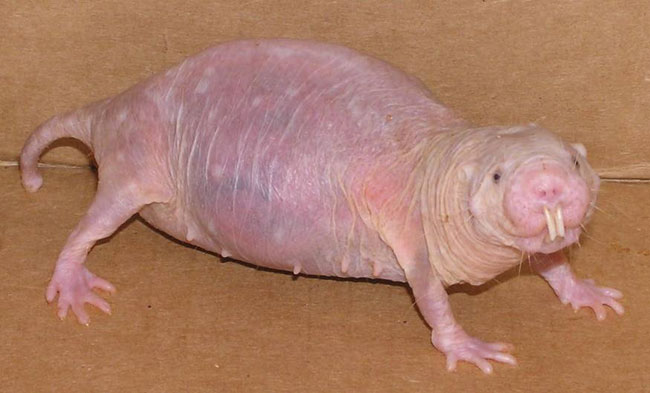Strange Creature Immune to Pain

As vulnerable as naked mole rats seem, researchers now find the hairless, bucktoothed rodents are invulnerable to the pain of acid and the sting of chili peppers.
A better understanding of pain resistance in these sausage-like creatures could lead to new drugs for people with chronic pain, scientists added.
Naked mole rats live in cramped, oxygen-starved burrows some six feet underground in central East Africa. Unusually, they are cold-blooded — which, as far as anyone knows, is unique among mammals.
"They're the nicest, sweetest animals I've ever worked with — they look frightening, but they're very gentle," said neurobiologist Thomas Park at the University of Illinois at Chicago
Scientists knew the mole rats were quite sensitive to touch — perhaps to help replace their almost useless eyes. After probing their skin, Park and his colleagues unexpectedly discovered the rodents lacked the chemical Substance P, which causes the feeling of burning pain in mammals.
Acid test
The researchers discovered that when unconscious mole rats had their paws injected with a slight dose of acid, "about what you'd experience with lemon juice," Park said, as well as some capsaicin — the active ingredient of chili peppers — the rodents showed no pain.
Sign up for the Live Science daily newsletter now
Get the world’s most fascinating discoveries delivered straight to your inbox.
"Their insensitivity to acid was very surprising," Park told LiveScience. "Every animal tested — from fish, frogs, reptiles, birds and all other mammals — every animal is sensitive to acid."
To explore their pain resistance further, the researchers used a modified cold sore virus to carry genes for Substance P to just one rear foot of each tested rodent. Park and his colleagues found the DNA restored the naked mole rats' ability to feel the burning sensation other mammals experience from capsaicin.
"They'd pull their foot back and lick it," Park said. Other feet remained impervious to the sting of capsaicin.
"Capsaicin is very specific for exciting the fibers that normally have Substance P," Park added. "They're not the fibers that respond to a pinprick or pinch, but the ones that respond after an injury or burn and produce longer-lasting pain."
Curiously, the researchers found that mole rats remained completely insensitive to acids, even with the Substance P genes. This suggests there is a fundamental difference in how their nerves respond to such pain.
"Acid acts on the capsaicin receptor and on another family of receptors called acid-sensitive ion channels," Park said. "Acid is not as specific as capsaicin. The mole rat is the only animal that shows completely no response to acid."
Why so insensitive?
Scientists theorize naked mole rats evolved this insensitivity to acid due to underground living. The rodents exhale high levels of carbon dioxide, and in such tight, poorly ventilated spaces it builds up in tissues, making them more acidic. In response, the mole rats became desensitized to acid.
"To give you an idea of what they experience, we normally all breathe in carbon dioxide levels of less than 0.1 percent. If people are exposed to an air mixture with as low as 5 percent carbon dioxide, we'll feel a sharp, burning, stinging sensation in our eyes and nose," Park said. "We hypothesize that naked mole rats live in up to 10 percent carbon dioxide."
Researcher Gary Lewin, a neuroscientist at the Max Delbrück Institute for Molecular Medicine in Germany, noted, "People may say, 'So what — it's weird, but what has it to do with human pain?' I think that is wrong, unimaginative and short sighted."
Lewin noted that all vertebrate pain-receptor systems "are built in a highly similar way, so the mole rat may tell us how you can unbuild the system."
Help for people
Specifically, Park noted this research adds to existing knowledge about Substance P. "This is important specifically to the long-term, secondary-order inflammatory pain. It's the pain that can last for hours or days when you pull a muscle or have a surgical procedure," he explained.
As such, these findings might shed new light on chronic pain. Park said,
"We're learning which nerve fibers are important for which kinds of pain, so we'll be able to develop new strategies and targets."
Lewin added, "We really do not understand the molecular mechanism of acid sensing in humans, although it is thought to be pretty important in inflammatory pain. An animal that naturally lacks such a mechanism may help us identify what the mechanism actually is."
Park next plans to study distantly related animals that dwell in similar circumstances, such as the Mexican free-tailed bat and the Alaskan marmot, which both spend large amounts of time in high carbon dioxide caves or burrows. "How are they surviving down there? It'd be interesting if we saw some parallels there with the naked mole rats," Park said.
The scientists detailed their findings online Jan. 28 in the journal PLoS Biology.
- The World's Ugliest Animals
- Amazing Animal Abilities
- The Pain Truth: How and Why We Hurt










